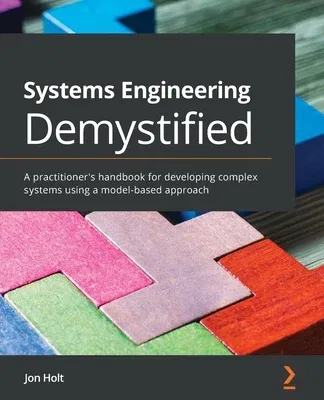Get to grips with systems engineering life cycles, processes, and best
practices and discover techniques to successfully develop complex
systems
Key Features:
-
Discover how to manage increased complexity and understand systems
better via effective communication
-
Adopt a proven model-based approach for systems engineering in your
organization
-
Apply proven techniques for requirements, design, validation and
verification, and systems engineering management
Book Description:
Systems engineering helps us to understand, specify, and develop complex
systems, and is applied across a wide set of disciplines. As systems and
their associated problems become increasingly complex in this evermore
connected world, the need for more rigorous, demonstrable, and
repeatable techniques also increases.
Written by Professor Jon Holt - an internationally recognized systems
engineering expert - this book provides a blend of technical and
business aspects you need to understand in order to develop successful
systems. You'll start with systems engineering basics and understand the
complexity, communication, and different stakeholders' views of the
system. The book then covers essential aspects of model-based systems
engineering, systems, life cycles, and processes, along with techniques
to develop systems. Moving on, you'll explore system models and
visualization techniques, focusing on the SysML, and discover how
solutions can be defined by developing effective system design,
verification, and validation techniques. The book concludes by taking
you through key management processes and systems engineering best
practices and guidelines.
By the end of this systems engineering book, you'll be able to
confidently apply modern model-based systems engineering techniques to
your own systems and projects.
What You Will Learn:
-
Understand the three evils of systems engineering - complexity,
ambiguous communication, and lack of understanding
-
Realize successful systems using model-based systems engineering
-
Understand the concept of life cycles and how they control the
evolution of a system
-
Explore processes and related concepts such as activities,
stakeholders, and resources
-
Discover how needs fit into the systems life cycle and which processes
are relevant and how to comply with them
-
Find out how design, verification, and validation fit into the life
cycle and processes
Who this book is for:
This book is for aspiring systems engineers, engineering managers, or
anyone looking to apply systems engineering practices to their systems
and projects. While a well-structured, model-based approach to systems
engineering is an essential skill for engineers of all disciplines, many
companies are finding that new graduates have little understanding of
systems engineering. This book helps you acquire this skill with the
help of a simple and practical approach to developing successful
systems. No prior knowledge of systems engineering or modeling is
required to get started with this book.


